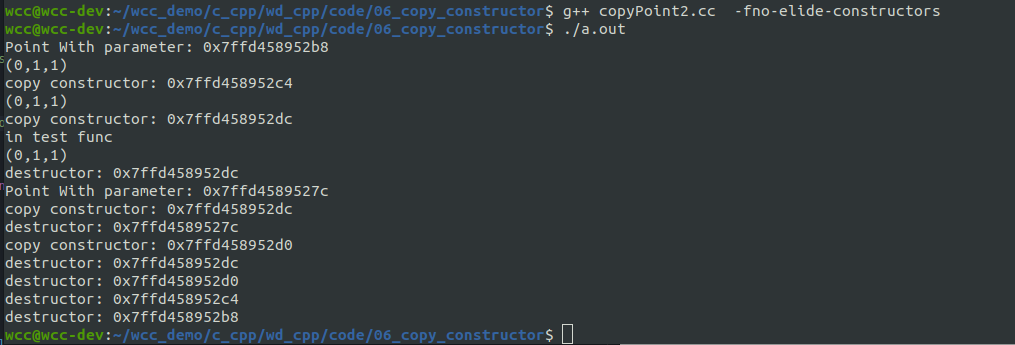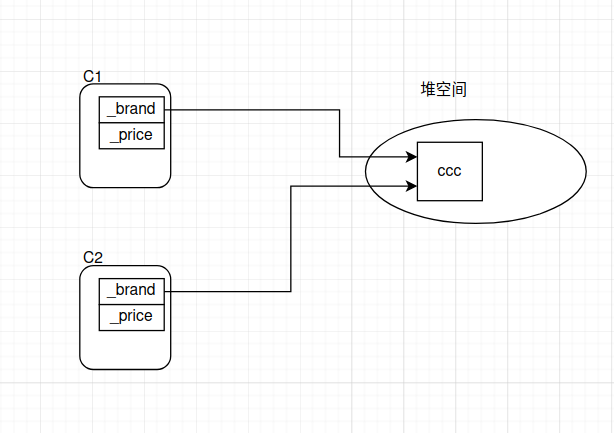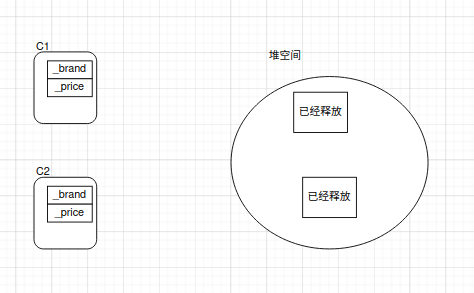拷贝构造函数
C++中经常会使用一个变量初始化另一个变量,如1
2int x = 1;
int y = x;
我们希望这样的操作也能作用于自定义类类型,如1
2Point pt1(1, 2);
Point pt2 = pt1;
这两组操作是不是一致的呢?第一组好说,而第二组只是将类型换成了Poin类型,执行Point pt2 = pt1;语句时,pt1对象已经存在,而pt2对象还不存在,所以也是这句创建了pt2对象,既然涉及到对象的创建,就必然需要调用构造函数,而这里会调用的就是复制构造函数,又称为拷贝构造函数。
当我们进行测试时,会发现我们不需要显式给出拷贝构造函数,就可以执行第二组测试。这是因为如果类中没有显式定义拷贝构造函数时,编译器会自动提供一个缺省的拷贝构造函数。其原型是:1
类名::类名(const 类名 &);
拷贝构造函数的使用方法如下:1
2
3
4
5
6
7
8
9
10
11
12
13
14
15
16
17
18
19
20
21
22
23
24
25
26
27
28
29
30
31
32
33
34
35
36
37
38
39
40
41
42
43
44
45
46
47
48
49
50
51
52
53
54
55
56
57
58
59
60
61
62
63
64
65
using std::cout;
using std::endl;
class Point{
public:
Point(int x, int y, int z){
cout << "Point With parameter" << endl;
_x = x;
_y = y;
_z = z;
}
Point(){
cout << "Point Without parameter" << endl;
}
Point(const Point& p)
:_x(p._x)
,_y(p._y)
,_z(p._z){
cout << "copy constructor" << endl;
}
~Point(){
cout << "destructor" << endl;
}
void set_loc(int x, int y, int z){
_x = x;
_y = y;
_z = z;
}
void print_info(){
cout << "(" << _x
<<"," << _y
<<"," << _z
<<")" << endl;
}
private:
int _x;
int _y;
int _z;
};
void test(){
Point p1(0,1,1);
p1.print_info();
Point p2 = p1;
p2.print_info();
}
int main(int argc, char* argv[])
{
test();
return 0;
}
在成员函数当中,定义了一个与拷贝构造函数。1
Point(const Point& p)
在test函数当中,当使用对象p1对对象p2进行赋值的时候,会自动调用拷贝构造函数。
拷贝构造函数的调用时机
拷贝构造函数的调用时机分为以下三种情况:
- 当用一个已经存在的对象初始化另外一个新的对象
- 当函数的参数是对象,使用实参初始化新参
- 当函数的返回值是对象,执行return语句的时候
1 |
|

通过上面的代码,可以来分析一下上面的拷贝构造函数执行的时机:
首先使用类生成了一个对象,在这里先调用了构造函数,生成对象p1.
然后创建一个对象p2并用p1进行初始化.这里会调用一次拷贝构造函数。
在接下来,调用了test_func函数,该函数的需要传递一个Point类型的参数,形参的初始化的过程当中会调用一次拷贝构造函数。
在test_func函数结束的时候,函数内部形参会调用一次析构函数。
在接下来调用了test_func1函数,在函数累不,首先生成了栈对象,在这里会先调用构造函数。
然后返回值传递的时候进行了一次拷贝构造函数的调用。
test_func1结束的时候,会执行一次析构函数。
在test函数当中,创建一个对象p3并且使用test_func1返回的对象进行初始化,这里会进行一次拷贝构造函数。
浅拷贝与深拷贝
前面举例子的时候,使用的都是比较简单的拷贝构造函数的例子,基本上是使用值传递的方式。在实际使用的时候,可能会遇到需要在堆上开辟空间的情况,这个时候默认构造函数就不一定适用了。下面举一个简单的例子:1
2
3
4
5
6
7
8
9
10
11
12
13
14
15
16
17
18
19
20
21
22
23
24
25
26
27
28
29
30
31
32
33
34
35
36
37
38
39
40
41
42
43
44
45
46
47
48
49
50
51
52
53
54
55
56
57
58
59
60
61
62
63
64
65
using std::cout;
using std::endl;
class Computer{
public:
Computer(const char * brand, float price)
:_brand(new char[strlen(brand)+1]())
,_price(price){
cout << "Computer(const char*, float)" << endl;
strcpy(_brand, brand);
}
Computer(const Computer & p)
:_brand(p._brand)
,_price(p._price){
cout << "Copy comstructor" << endl;
}
~Computer(){
if (_brand) {
cout << "brand:" <<_brand <<" price:" << _price << endl;
delete [] _brand;
_brand=nullptr;
cout << "Destructor ~Computer()" << endl;
}
cout << "Destructor resource free" << endl;
}
void set_price(float price);
void print_info();
private:
char * _brand;
float _price;
};
void Computer::set_price(float price){
_price = price;
}
void Computer::print_info(){
cout << "brand: " << _brand << endl;
cout << "price: " << _price << endl;
}
void test(){
Computer c1("ccc", 300);
Computer c2(c1);
cout << "test end" << endl;
}
int main(int argc, char* argv[])
{
test();
cout << "program finished" <<endl;
return 0;
}

在上面的代码当中,在test函数当中创建了两个对象。类的成员变量_brand是一个指针,且在生成对象的时候动态申请。
在使用c1对对象c2进行初始化的时候,由于默认的拷贝构造函数当中使用了值传递的方式,因此将c2的_brand的指向,指向了和c1的_brand相同。
如下图所示:
当函数test结束的时候,c2对象先出栈,并且执行析构函数,因此会释放指针指向的空间,但是此时对象C1的_brand还是指向该空间。
然后在对象c1执行析构函数的时候,再次去释放该空间,从而导致上前面图中出现的两次释放的问题。
从这里可以看出,只是进行值传递的浅拷贝不适合我们的目的,因此我们需要对拷贝构造函数进行修改:1
2
3
4
5
6
7
8
9
10
11
12
13
14
15
16
17
18
19
20
21
22
23
24
25
26
27
28
29
30
31
32
33
34
35
36
37
38
39
40
41
42
43
44
45
46
47
48
49
50
51
52
53
54
55
56
57
58
59
60
61
62
63
64
65
66
67
using std::cout;
using std::endl;
class Computer{
public:
Computer(const char * brand, float price)
:_brand(new char[strlen(brand)+1]())
,_price(price){
cout << "Computer(const char*, float) :" << this << endl;
strcpy(_brand, brand);
}
Computer(const Computer & p)
:_brand(new char[strlen(p._brand)+1]())
,_price(p._price){
cout << "Copy comstructor: " << this << endl;
strcpy(_brand, p._brand);
}
~Computer(){
cout << "Destructor resource free" << this << endl;
if (_brand) {
cout << "brand:" <<_brand <<" price:" << _price << endl;
delete [] _brand;
_brand=nullptr;
cout << "Destructor ~Computer()" << endl;
}
}
void set_price(float price);
void print_info();
private:
char * _brand;
float _price;
};
void Computer::set_price(float price){
_price = price;
}
void Computer::print_info(){
cout << "brand: " << _brand << endl;
cout << "price: " << _price << endl;
}
void test(){
Computer c2("ccc", 300);
Computer c3(c2);
cout << "test end" << endl;
}
int main(int argc, char* argv[])
{
test();
cout << "program finished" <<endl;
return 0;
}
该拷贝构造的过程如下:
